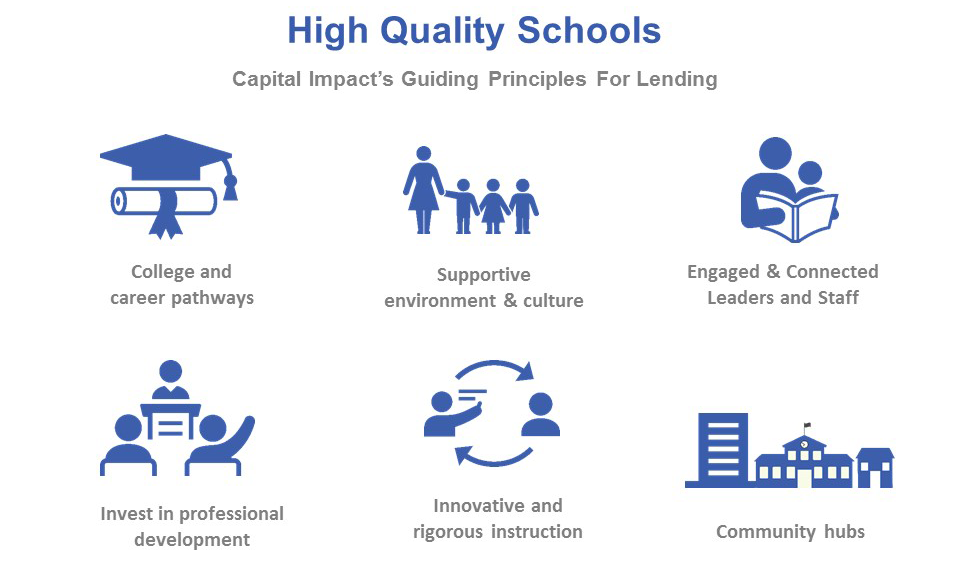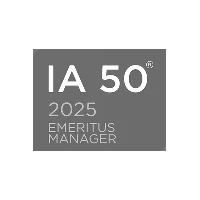By Emilie Linick, Senior Loan Officer, and Quanic Fullard, Impact Strategy Specialist
Capital Impact Partners has long been driven by a mission to help people build communities of opportunity that break barriers to success. To that end, we continually look to expand our lending and incubate, scale, and advocate for new ideas that advance community development for those most in need.
As a mission-driven Community Development Financial Institution (CDFI), advancing projects and programs that deliver critical social services is a big part of the work we do to achieve our 2020 Vision for communities.Through this vision, we seek to address systemic poverty, create equity, build healthy communities, and promote inclusive growth through investments in projects that deliver a variety of high-quality services and programs for communities that have traditionally lacked access to them.

We focus on expanding education access in communities where those opportunities do not exist in the public school framework.
Education has been central to this effort for more than two decades. That’s why we focus on engaging with partners who deliver solid educational opportunities for students in communities where those opportunities don’t exist within the local public school framework. We are strong supporters of public education and want to see it succeed, yet achieving true reform in public education is a slow process that will skip entire generations of young people.
In order to provide opportunity in the absence of other reform, we see financing high performing charter schools in low- and moderate-income communities as critical to promoting equitable access to education for all students, regardless of socioeconomic status, race, or ethnicity.
What Are Charter Schools?
Capital Impact does not believe there is an “either-or” solution that fits all educational needs across the nation. Instead, we fully support a variety of systems and dedicated educators that foster a high achieving school environment for everyone. This includes charter schools.

We do not believe there is an “either-or” solution that fits all educational needs across the nation.
Recent political discourse has focused public attention on a variety of approaches to K-12 education, frequently placing charter schools in the spotlight. Some charter schools have received negative press for operating as purely for-profit entities that fail to deliver improved educational opportunities for marginalized students.
All of this has contributed to public confusion about the place of charter schools, not unlike the views documented in a 2014 PDK/Gallup poll finding “most Americans misunderstand charter schools.”
This is why it’s important to understand distinctions among charter schools. According to the National Alliance for Charter Schools, charter schools are public schools that offer the following:
- Access for all children
- Free tuition
- No special entrance requirements.
Why We Finance Charter Schools
For over 25 years, charter schools have been instrumental in fostering innovation in the education space. Charter school educators have more freedom to innovate and tailor their pedagogy to the specific needs and unique learning styles of students who live in the communities they serve.
In a 2008 study conducted by The Center on Reinventing Public Education, authors note that while charter schools “do not appear more likely to adopt entirely new instructional designs than other public schools,” charters are “more likely to adopt and sustain best practices, experiment with new uses of funding and governance, and repackage existing practices in new combinations.”

Charter schools have more freedom to innovate and tailor their curriculum to the specific needs of students who live in the communities they serve.
Charter schools share their technological tools and best practices with traditional public schools, the latter of which often make changes in their teaching methods as a result. For example, Envision Learning Partners utilizes models developed by Envision Education to train both charter schools and traditional public schools alike. Meanwhile, a 2017 study entitled “Bridging the District-Charter Divide to Help More Students Succeed” provides further evidence of charter-public school collaborations.
A 2015 study by Stanford University’s Center for Research on Education Outcomes, researchers found charter schools frequently fill the gaps left open by publication education and reported: “urban charter schools in the aggregate provide significantly higher levels of annual growth in both math and reading compared to their traditional public school peers.”
Capital Impact focuses its lending efforts on supporting public charter schools in those communities where the traditional public system is underperforming or failing. At the same time, we are also cognizant of the need to ensure our engagement with those schools whose models reflect high expectations and performance standards.
Six Attributes of High-Quality Schools We Support
Capital Impact is highly selective in the charter schools it finances. We want positive, long-term impact for students. Thus, we don’t finance just any charter school; we look for schools operated by reputable and dedicated charter management companies, most of them mission oriented, nonprofit organizations, and emerging school networks and stand-alone schools that are making strides in delivering student pathways to success.
To help guide our lending decisions, we evaluate schools’ quality using the following six attributes, many of which are derived from a collaboration between the University of Chicago and the Urban Education Institute known as “UChicago Impact.” Their evidence-based system, which drives improvement in schools nationwide, is based on more than 20 years of research.
1. Innovative and rigorous instruction: There is no question that rigor, based on best practices and innovative learning models, is at the core of all high-quality charter schools. We look for schools focused on data driven instruction, maintain high expectations with extensive support systems in place for students who may struggle to meet those expectations, and assess subgroups and individual student growth.
2. Supportive environment and culture: In addition to strong academics, high-quality schools infuse their learning environments with a compelling and intentional set of core values (such as grit, persistence, or resilience). Those values are part and parcel of the school’s day-to-day culture and provide a guiding framework for students and staff. Capital Impact believes high-quality schools provide an expanded definition of student success focused on character growth and development of social and emotional skills that will help students become engaged citizens. In addition, we believe a safe and welcoming school facility creates dignity and a sense of ownership and empowerment among students, staff, and families.
3. Engaged and connected leaders and staff: Strong schools demonstrate clear evidence of the leadership’s and staff engagement and connection to the communities they serve.
4. Professional development: We believe high-quality schools invest in and retain their teachers and staff and provide opportunities for advancement into leadership positions, while also fostering a collegial environment for both faculty and students.
5. Career and/or college pathways: We support schools that promote education as a pathway to and through college and provide the necessary tools to help students persist through graduation and also support schools that promote vocational trades, as demonstrated in the University of Chicago study “Foundations for Young Adult Success: A Development Framework”.
6. Community hubs: Capital Impact supports schools that promote family and community engagement by building authentic relationships, forging strong partnerships with a variety of community organizations that provide services to families, and/or engaging parents to advocate and organize to take strategic action to improve public education. Many schools also offer access to health care and healthy food. We have joined with leaders at Equitas Academy, El Sol, and Green Dot to present success stories at national conferences to further amplify this hub approach.
Two High Performing Charter School Examples
Equitas Academy, in the Pico Union neighborhood near downtown Los Angeles, California, is one of several charter schools Capital Impact has funded that exemplifies these attributes. The majority of students qualify for the free or reduced lunch programs, and more than 60 percent are speakers of English as a second language.

Equitas Academy goes beyond traditional subjects to teach public speaking and debate to prepare students for college-level readiness skills.
School founder Malka Borrego employs a staff of teachers who are critically devoted to ensuring no student falls behind academically and that academics go well beyond traditional subjects to take into account college-level and career readiness skills like public speaking and debate.
Why such subjects for elementary students? Administrators and staff expect every student will pursue higher education and come out with degrees and provides information and resources to support families in achieving this dream. College banners line school walls, and students regularly visit college campuses. At Capital Impact, we believe that teachers’ expectations make a difference in student achievement.

The El Sol Arts and Science Academy campus is also home to a state-of-the-art health clinic providing a wide range of services to students and the community.
El Sol Arts and Science Academy is another school that we financed in partnership with The California Endowment. El Sol plays the role of a community hub, collaborating with Share Our Selves (SOS) to open a state-of-the-art health care clinic on its campus that provides a wide range of health care, education, and social services for both students’ families and the broader community.
The SOS-El Sol Wellness center accepts everyone, including those who are uninsured or cannot afford to pay. El Sol has been named both a Bright Spot Awardee by The White House Initiative on Educational Excellence for Hispanics as well as 2014 Hart Vision Charter School of the Year, which recognizes top schools throughout the state of California.
Supporting School Integration
There is still more work to do, however, in improving the charter school model. Capital Impact supports an emerging model called “diverse by design,” which a growing number of charter schools across the country have embraced. These schools focus on intentional racial and socioeconomic integration.
Diverse by design schools not only create equitable access to much needed educational resources but promote intercultural and cross-racial interaction that facilitates understanding, reduces biases, and improves critical thinking and creativity.

Diverse by design schools not only create equitable access to much needed educational resources but promote intercultural and cross-racial interaction.
Capital Impact’s support of the diverse by design model has come out of extensive interviews with preeminent thought leaders and researchers as well as the performance of a comprehensive literature review. We believe integrated schools are beneficial to all students, and substantial independent research has demonstrated that the makeup of a school can play a more significant role in closing the achievement gap than a family’s income level.
Charter schools are in a good position to advance this model because they have more freedom to determine geographic location, curriculum, school culture, recruitment, and discipline policies that promote successful integration.
For example, charter schools can implement the diverse by design model by locating a charter school on the border of two to three socioeconomically different neighborhoods and using a weighted lottery system to recruit applicants while at the same time ensuring staff are fully trained in culturally sensitive pedagogical practices and restorative justice approaches.
We’ll continue to explore this topic with the Diverse Charter Schools Coalition and write more about this concept – and our progress in screening deals that use this model – in a future blog post.
Our Role in Financing and Supporting Charter Schools
Developing and launching a new school while navigating the obstacles to building or purchasing an educational facility can be daunting for a lot of charter school operators. That’s where Capital Impact Partners can help. We have a long history of financing charter schools, providing our first loan over 25 years ago. To date, we have offered $738 million in financing to 235 charter schools, increasing access to over 235,000 students across the country.

Capital Impact has a long history of financing charter schools, providing our first loan over 25 years ago. We have since disbursed more than $700 million to support education.
As a result of this track record, we’ve seen–and helped schools overcome–a variety of challenges. As both your lender and your partner, we can offer a financing package that makes sense for your specific project. And to help ensure your long-term success, we can provide capacity building support and technical assistance to help your school and students grow and thrive. An updated version of our Answer Key, a critical document that guides charter schools in the planning and financing of their facility projects, will provide further assistance in this area. We will update this blog with a link to that publication when it is available in the Fall of 2017.
We believe all students, regardless of their race or socioeconomic status, should have access to a high-quality education, and it is through highly targeted charter school funding that we help make that vision a reality.
If you are a like-minded charter school leader or mission driven developer looking to construct and open a new facility or expand an existing facility, please contact us!
[dcwsb inline=”true”]








